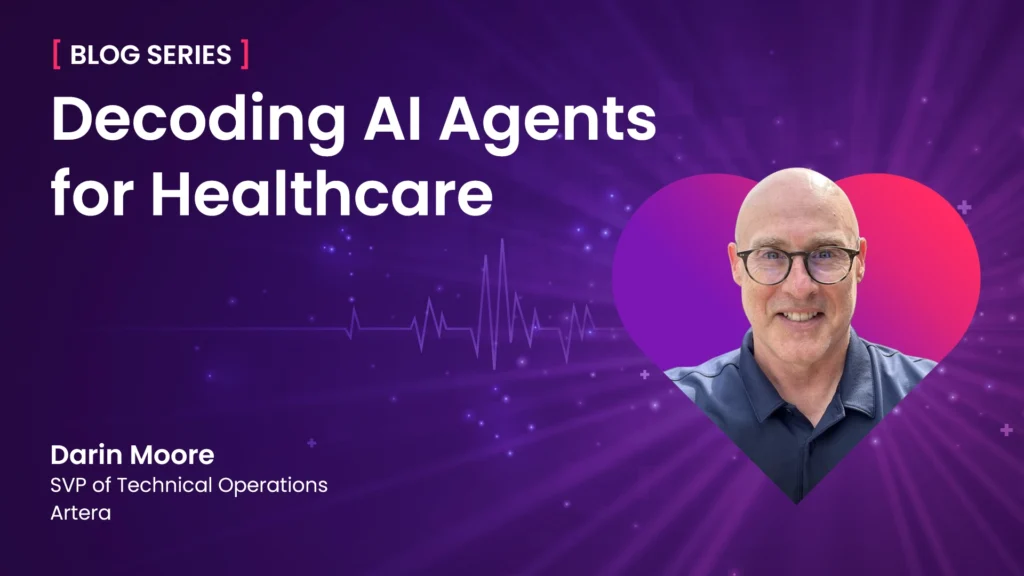By: Guillaume de Zwirek, CEO and Founder, Artera
When you type “patient engagement” into Google, you are inundated with hundreds of companies and solutions. Despite serving a variety of unique purposes, these companies are wrapped into a single category: “patient engagement.” By grouping these companies under the same “patient engagement” umbrella, we’re doing a disservice to the industry and creating a more confusing experience than it needs to be.
What is patient engagement – really? I recently shared my thoughts at ViVE 2024 as part of the Tech Innovation Showcase.
In my presentation, I shared…
- Proprietary research on the state of patient engagement today
- Four core components of a modern patient engagement system
- My market map that groups vendors by category to help you make sense of the crowded “patient engagement” market
Below is a recap and key findings.
Artera: 9+ Years with a Front Row Seat to Patient Engagement
I’ve been studying patient engagement since before patient engagement was coined as a term – and before TCPA had an exemption that allowed for many of the workflows we rely on today.
I’ve had the great fortune of scaling Artera, since I founded it in 2015, and work with some of the most amazing healthcare organizations. We now handle over two billion communications across 100 million active patients per year, working with 800+ healthcare facilities and federal agencies, as well as 50+ partners in our marketplace.
At Artera, for 9+ years, we have a front-row seat to the ins and outs of patient engagement. We’ve seen a lot of the things that can go wrong with patient communications – whether it is broken or unorganized workflows, spamming patients with duplicate automations, lab results and survey requests.
But we’ve also seen a lot of things that can go right, such as quick help with tech support, clinical triage or urgent assistance.
All of this shows that customer service in healthcare matters – and impacts patient engagement, deeply.
Proprietary Research: The State of Patient Engagement Today

Our team recently conducted a body market research to look into this:
First, when you deliver a broken communications experience or if you don’t have a handle on what’s going on across your vendors and service lines enterprise-wide, you are priming your patients to leave (or be stolen by a competitor).

Additionally, patients on average have 11 different vendors that are independently messaging them throughout their care journey – on a fragmented and disjointed basis. This could mean a specialist solution, appointment reminder system, patient portal, etc. are all competing for your patient’s attention in a way that is both confusing and frustrating for the patient.
Due to the broken communication experience they’re provided, nearly half of patients do not pay their bills on time. While patients want to communicate via text with their provider, if we do it poorly, they will leave. So, how do we make sense of this all?
Patient Engagement Framework: The Communications Highway
Patient communication is nuanced and complicated – there are a lot of vendors looking to communicate with your patients and a lot of workflows you may want to create. The greatest analogy I’ve come up with for this is a highway – a complicated and multifaceted system that requires a robust infrastructure. Like this:

Let’s dive into the four building blocks of the highway and make a connection to the core components of the patient engagement system:
- Gateway with APIs: For a highway, the first thing you’d need to construct is a wide road that goes from point A to point B, ideally managing a lot of traffic going in the same direction. In the patient engagement universe, this requires adopting a common infrastructure – a single communications gateway that manages all of your patient outreach. Vendors like Artera, Twilio, Cisco and Syniverse offer such technology, known in the industry as a “Communication Gateway.”
- Vibrant Marketplace: With all good highways, you need good on-ramps and off-ramps to let drivers pull off depending on their needs. Patients have a similar experience in terms of their unique care journeys. In the patient engagement space, you need a framework for letting vendors and tools onto your system – a suite of APIs and a rich and vibrant marketplace that enables your patients to be taken on the right journey. Artera manages this type of marketplace, as do more traditional players like CRMs and EMRs, although they typically do not have communication APIs available to those partners.
- Rules & Master Preference Index: It’s not enough to have on-ramps and off-ramps if no one knows they exist, so you need to have road signs. In the patient engagement universe, we call these rules; we believe healthcare organizations need to make a strategic decision around governance – how frequently communication is going out, what outreach should be prioritized, etc.
- Normalized Data Store: It’s impossible to know what’s going on every minute on a highway, but speed traps can help reduce major accidents. In patient engagement, we call this a normalized data store – a comprehensive inventory of all communication data spanning across the patient journey. Your entire universe of solutions should route their engagement data into a single data warehouse, so you can analyze and identify what’s working, what’s broken, and how to fix it.
Patient Engagement as an Infrastructure
Now that we’ve looked at the core components of a patient engagement system, let’s come back to the original challenge: we have seemingly infinite vendors classified as patient engagement, but very few who actually offer the core building blocks necessary to deliver a great patient experience.
Just as owning a high-quality camera doesn’t make one a professional photographer, having a feature that allows you to communicate with patients doesn’t make you a patient engagement company. Even our industry research groups struggle with this problem – the Best in KLAS leader for patient engagement is a billing company (a wonderful one too, I might add) that, to my knowledge, doesn’t offer any of these core capabilities!
Whether it’s through Artera or someone else, we believe the future of patient engagement should provide patients with:
- easy and logical access
- all their communication in one place
- the right communication at the right time
- and the appropriate tools to opt in or out of outreach
And we believe this is only possible if communication is thought of at the infrastructure layer… something that every technology solution needs to build on top of.
Now it’s time to work together to make this new patient engagement framework a reality.
To view my ViVE 2024 presentation, please check out this page.



